

Contents | 101st Airborne History | 501st Parachute Infantry Regiment | 501st Parachute Infantry Regiment D-Day Battle | 506th Parachute Infantry Regiment
Excerpts from "Order of Battle -
Operation Overlord - Utah Beach & the US Airborne Divisions 6 June 1944"
James Arnold & Roberta Wiener - Ravelin Limited 1994
US 101st Airborne Division WWII
History
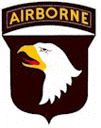 The
101st Airborne Division was activated at Camp Claiborne, Louisiana on 16 August
1942 under command of Major General William C. Lee and transferred to Fort
Bragg, North Carolina in September. It was one of two airborne divisions created
by dividing up the 82d Infantry Division. General Lee said of the division: “The
101st Airborne... has no history, but it has a rendezvous with destiny…”
The
101st Airborne Division was activated at Camp Claiborne, Louisiana on 16 August
1942 under command of Major General William C. Lee and transferred to Fort
Bragg, North Carolina in September. It was one of two airborne divisions created
by dividing up the 82d Infantry Division. General Lee said of the division: “The
101st Airborne... has no history, but it has a rendezvous with destiny…”
General Lee had played an early role in American airborne history. After serving in France in World War I as a platoon leader and a company commander, he taught military science and became an expert in tank warfare. As a major in the Office of the Chief of Infantry, Lee worked on the development of the infantryman as a paratrooper, studying the methods of the U S Forest Service fire-jumpers.
A test platoon was formed from infantry volunteers in July 1940, and they made their first jump on 16 August. Some of the battalion combat leaders in the 101st at Normandy served in the battalion that grew out of this test platoon, including. Robert F. Sink, Julian Ewell, Patrick J. Cassidy, Robert G Cole, as well as Robert L. Strayer who became a regimental commander. As a colonel, Lee assumed leadership of the Airborne Command at Fort Bragg on 21 March 1942. As a general, he established the Parachute School at Fort Benning, Georgia in May.
The 101st Airborne Division in its initial form comprised: Headquarters, the 502d Parachute Infantry, the 327th and 401st Glider Infantries, the divisional artillery, the 377th Parachute Field Artillery Battalion, the 321st and 907th Glider Field Artillery Battalions, the 101st Airborne Signal Company, 326th Airborne Engineer Battalion, 426th Airborne Quartermaster Company and the 326th Airborne Medical Company. By 1944 the division had added the 81st Airborne Anti-aircraft Battalion and several auxiliary companies and platoons, as well as combat attachments comprising three more entire tank and tank destroyer battalions.
The 101st Airborne sailed to England in September 1943 where they took part in training exercises and practice jumps for their first combat of the war. When General Lee suffered a heart attack, the division passed to the command of Major General Maxwell D. Taylor in March 1944.
On 6 June 1944, the 101st shared in the air and sea assault of Normandy. In the predawn hours, the 502d Parachute Infantry Regiment and the attached 501st and 506th Parachute Infantry Regiments parachuted behind enemy lines, while supporting divisional units arrived by sea and gliders brought in equipment and troops. The division played a key role in the capture of Carentan. The 101st returned to England on 13 July for rehabilitation. Airborne leaders were eager to stage another major operation. However, such was the speed of the allied pursuit across France and Belgium that no sooner had an operation been prepared than the ground forces had already overrun the proposed landing zones. Then came Arnhem, the proverbial "bridge too far”. The 101st air assaulted Nijmegen-Arnhem, Holland on 17 September 1944. It took the Veghel and Zon bridges, as well as Eindhoven, Zon, St. Oedenrode, Veghel, and Schijndel. On 28 November, the division was relieved and returned to France.
The division returned to action in the Ardennes on 18 December 1944 under the temporary command of Brigadier General Anthony McAuliffe. Its epic defense of surrounded and besieged Bastogne won the entire division the Distinguished Unit Citation. When the Germans demanded surrender on 22 December, General McAuliffe replied with the now legendary, “Nuts" The general later said of his men: “With the type of soldier I had under my command, possessing such fighting spirit, all that I had to do was to make a few basic decisions – my men did the rest."
On 25 February 1945, the 101st retired to France for rehabilitation. In late March, the division moved out to hold the Ruhr pocket, from where they sent periodic patrols across the Rhine. It took up military government duties while advancing across southern Germany into Bavaria. Ordered to march on Berchtesgaden on 4 May, the division suffered its last three battle casualties en route as the war came to an end. After a period of occupation in southern Germany and Austria, the “Screaming Eagles” returned to France on 1 August 1945. The division was inactivated in France on 30 November.
During the course of hostilities the division lost 1,766 killed and 6,388 wounded, of whom 324 later died of their wounds. Two men of the division, from the 502d Parachute Infantry Regiment, won the Medal of Honor, one of which was for the invasion of Normandy. In sum, the 101st participated in the World War II campaigns of Normandy, Rhineland, Ardennes-Alsace, and Central Europe.
501st Parachute Infantry Regiment
 The
501st Parachute infantry Regiment was constituted 24 February 1942 in the Army
of the United States, activated at Camp Toccoa, Georgia on 15 November 1942,
assigned to the Airborne Command a month later, and moved to Fort Benning,
Georgia in March 1943. The 501st Parachute Battalion, which had been activated
in October 1940 at ort Benning, became the regiment's 1st Battalion. The
regiment was assigned to the 2d Airborne Brigade in September 1943 and sailed to
England January 1944, where it was attached to the 101st Airborne Division in
May 1944.
The
501st Parachute infantry Regiment was constituted 24 February 1942 in the Army
of the United States, activated at Camp Toccoa, Georgia on 15 November 1942,
assigned to the Airborne Command a month later, and moved to Fort Benning,
Georgia in March 1943. The 501st Parachute Battalion, which had been activated
in October 1940 at ort Benning, became the regiment's 1st Battalion. The
regiment was assigned to the 2d Airborne Brigade in September 1943 and sailed to
England January 1944, where it was attached to the 101st Airborne Division in
May 1944.
 Under
command of Colonel Howard R. Johnson (who made mare than 100 career parachute
lumps before his death in action in Holland), the 501st parachuted behind enemy
lines at Utah Beach on 6 June 1944 with the mission of capturing the
la Barquette locks on the Douve River. Along with the 506th Infantry, the regiment
captured an entire enemy battalion on the day after D-Day. The regiment returned
to England on 13 July
1944 with its division.
Under
command of Colonel Howard R. Johnson (who made mare than 100 career parachute
lumps before his death in action in Holland), the 501st parachuted behind enemy
lines at Utah Beach on 6 June 1944 with the mission of capturing the
la Barquette locks on the Douve River. Along with the 506th Infantry, the regiment
captured an entire enemy battalion on the day after D-Day. The regiment returned
to England on 13 July
1944 with its division.
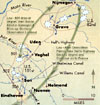 On
17 September 1944, the regiment participated in the air assault on
Nijmegen-Arnhem. The 501st captured Eerde, then advanced on Heeswijk, taking 418
prisoners in the process. With Dutch citizens providing information on enemy
positions, the regiment took Schijndel and Veghel on 21-22 September. In October
the 501st sent out a patrol on a daring mission into enemy territory. They were
covertly to observe German movements, capture an enemy vehicle and prisoners,
and drive them back to their base. The six-man patrol returned with 32
prisoners.
On
17 September 1944, the regiment participated in the air assault on
Nijmegen-Arnhem. The 501st captured Eerde, then advanced on Heeswijk, taking 418
prisoners in the process. With Dutch citizens providing information on enemy
positions, the regiment took Schijndel and Veghel on 21-22 September. In October
the 501st sent out a patrol on a daring mission into enemy territory. They were
covertly to observe German movements, capture an enemy vehicle and prisoners,
and drive them back to their base. The six-man patrol returned with 32
prisoners.
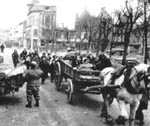
The
regiment moved to France in November, and returned to action in the Ardennes on
18 December 1944. The 101st Airborne's epic defense of Bastogne is well-known.
The 501st moved into Germany on 4 April 1945 and remained there until
inactivated on 20 August 1945. The regiment’s coat of arms commemorates
its role in the liberation of Veghel, Holland and its combat at Bastogne,
Belgium. Its motto, "Geronimo,” was first heard during the initial jump of the
regiment’s test platoon and has been m use ever since.
The full regiment received Presidential Unit Citations for its conduct in Normandy and Bastogne and the French Croix de Guerre with Palm for its conduct in Normandy.
501st Parachute Infantry Regiment D-Day Battle
The 501st Parachute Infantry's 1st Battalion had the mission to capture the lock
on the Douve River at la Barquette. This lock controlled the river's water level
to the west as far as the confluence of the Merderet. In German hands it could
provide an important obstacle to the break-out from Utah Beach. The 2d Battalion
would blow the Douve bridges on the main road from St. Côme-du-Mont to Carentan.
If possible, the regiment would take St. Côme-du-Mont and destroy the rail
bridge to the west.
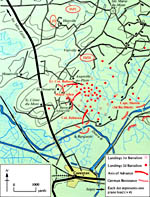 The
regiment was badly dispersed during its drop. Particularly hard hit were members
of the 1st Battalion command group. However, the regiment's commander, Colonel
Howard R. Johnson, landed squarely in the middle of the planned drop zone.
Moving toward his objective, Johnson collected some 140 miscellaneous men.
Sending 50 men ahead to overrun the lock, Johnson placed the balance of his
force in defensive positions near the lock. After securing this prime objective,
Johnson sent combat patrols toward the bridges 2,000 yards away. This effort
drew heavy German fire and decided the colonel to limit himself to holding the
lock while trying to move north to make contact with elements of his regiment at
Bse. Addeville. Johnson took about 50 men
toward this village in hopes of collecting enough strength to continue against
St. Côme-du-Mont. Arriving at Bse. Addeville around 0900, Johnson found that his
regimental S-3 Major R.J. Allen, had collected a mere 100 miscellaneous men and
that they were already engaged with Germans to the north and west. Johnson was
puzzled as to how to proceed given the paucity of strength.
The
regiment was badly dispersed during its drop. Particularly hard hit were members
of the 1st Battalion command group. However, the regiment's commander, Colonel
Howard R. Johnson, landed squarely in the middle of the planned drop zone.
Moving toward his objective, Johnson collected some 140 miscellaneous men.
Sending 50 men ahead to overrun the lock, Johnson placed the balance of his
force in defensive positions near the lock. After securing this prime objective,
Johnson sent combat patrols toward the bridges 2,000 yards away. This effort
drew heavy German fire and decided the colonel to limit himself to holding the
lock while trying to move north to make contact with elements of his regiment at
Bse. Addeville. Johnson took about 50 men
toward this village in hopes of collecting enough strength to continue against
St. Côme-du-Mont. Arriving at Bse. Addeville around 0900, Johnson found that his
regimental S-3 Major R.J. Allen, had collected a mere 100 miscellaneous men and
that they were already engaged with Germans to the north and west. Johnson was
puzzled as to how to proceed given the paucity of strength.
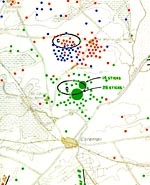 Later
in the morning, having heard the reassuring news broadcast by the BBC that the
invasion ‘1s going according to plan", Johnson decided to proceed with the
regional mission. Leaving a small force at Bse. Addeville, he returned to the
lock in preparation for an advance against the bridges. Then he learned that
some 250 men of his 2d Battalion, led by Colonel Bullard, were heavily engaged
some 1,000 yards to the northwest. He badly wanted these men to join his own
command to give him the strength to attack the bridges. The problem was that
German forces interposed between the two American units. While Johnson led a
relief force toward Bullard, heavy German pressure built up against the
paratroop force defending the lock. Fortunately, a naval shore fire control
officer managed to direct remarkably accurate fire from the cruiser Ouincy
against the German position. Emboldened by this success, Johnson tried again
to take the Douve bridges. Again heavy German fire thwarted this effort. He
lacked the manpower to accomplish his secondary missions.
Later
in the morning, having heard the reassuring news broadcast by the BBC that the
invasion ‘1s going according to plan", Johnson decided to proceed with the
regional mission. Leaving a small force at Bse. Addeville, he returned to the
lock in preparation for an advance against the bridges. Then he learned that
some 250 men of his 2d Battalion, led by Colonel Bullard, were heavily engaged
some 1,000 yards to the northwest. He badly wanted these men to join his own
command to give him the strength to attack the bridges. The problem was that
German forces interposed between the two American units. While Johnson led a
relief force toward Bullard, heavy German pressure built up against the
paratroop force defending the lock. Fortunately, a naval shore fire control
officer managed to direct remarkably accurate fire from the cruiser Ouincy
against the German position. Emboldened by this success, Johnson tried again
to take the Douve bridges. Again heavy German fire thwarted this effort. He
lacked the manpower to accomplish his secondary missions.
While the action around the
lock was taking place, the 2d Battalion had assembled between Angouville-au-Plain
and les Droueries. Colonel Ballard tried to move toward the lock but encountered
stiff resistance. Persistent efforts to force through to maneuver around the
German position at les Droueries failed in the face of small arms and mortar
fire.
On D-Day, the 501st Parachute Infantry managed to capture its prime objective, the lock at la Barquette. However, strong resistance kept it from seizing St. Côme-du-Mont and destroying the rail and highway bridges north of Carentan.
506th
Parachute Infantry Regiment
 The
506th Parachute Infantry Regiment was constituted in the Army of the United
States on 1 July 1942, activated at Camp Toccoa, Georgia on 20 July 1942, and
moved to Fort Benning in December, at which time it was attached to the Airborne
Command The regiment was attached to the 101st Airborne Division from 1 June
1943 to 1 March 1945, and permanently assigned to the division thereafter.
Following several re-locations within the U.S., the 506th sailed to England in
September 1943 Colonel Robert F. Sink commanded the regiment through all of its
World War II campaigns.
The
506th Parachute Infantry Regiment was constituted in the Army of the United
States on 1 July 1942, activated at Camp Toccoa, Georgia on 20 July 1942, and
moved to Fort Benning in December, at which time it was attached to the Airborne
Command The regiment was attached to the 101st Airborne Division from 1 June
1943 to 1 March 1945, and permanently assigned to the division thereafter.
Following several re-locations within the U.S., the 506th sailed to England in
September 1943 Colonel Robert F. Sink commanded the regiment through all of its
World War II campaigns.
On 6 June 1944, the 506th parachuted behind enemy lines at Utah Beach with the objectives of capturing two bridges over the Douve River and seizing an area containing two beach exits In the ensuing days, the 506th shared in the capture of an entire German battalion, took Vierville, captured Carentan, and parried an attempt to retake the town. The regiment returned to England on 13 July with its division.
The 506th shared in the 101st Airborne's assault of Nijmegen-Arnhem on 17 September 1944. On 23 September, the regiment reopened the Veghel-Uden highway, and drove the enemy from the Koevering roadblock two days later. The division moved to France for rehabilitation in late November.
The division returned to action at Bastogne on 18 December 1944. Its epic defense of the surrounded town is well-known On 9 January 1945, the 506th moved on Recogne, and several days later seized Foy-Notre-Dame, and then Neville and Rachamps.
The division relieved the 97th Infantry Division in Germany on 4 April 1945 A patrol from the 506th conducted a raid across the Rhine on 11-12 April. The 506th was inactivated along with the rest of the 101st Airborne in France on 30 November 1945.
The regiment's coat of arms recalls its Georgia origins, its two air-assaults, its capture of Eindhoven, Holland, and its defense of Bastogne. The full regiment received Presidential Unit Citations for its conduct in Normandy and Bastogne, and the French Croix de Guerre with Palm for its conduct in Normandy. In sum, the World War II campaigns of the 506th infantry are Normandy, Rhineland, Ardennes-Alsace, and Central Europe.